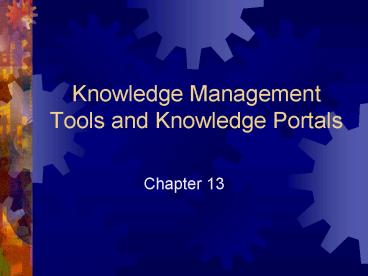Knowledge Management Tools and Knowledge Portals - PowerPoint PPT Presentation
1 / 29
Title:
Knowledge Management Tools and Knowledge Portals
Description:
Disadvantages: expensive, often does not ... Advantages: cheap. Disadvantages: limited communication medium. Web-Based Discussion Forums ... Notes groupware. ... – PowerPoint PPT presentation
Number of Views:4262
Avg rating:3.0/5.0
Title: Knowledge Management Tools and Knowledge Portals
1
Knowledge Management Tools and Knowledge Portals
- Chapter 13
2
PortalsThe Basics
- Portals are considered to be virtual workplaces
that - Promote knowledge sharing among different
categories of end users - Provide access to stored structured data
- Organize unstructured data
3
The Basics (contd)
- Portals are tool that could
- Simplify access to data stored in various
application systems - Facilitate collaboration among employees
- Assist the company in reaching its customers
4
The Basics (contd)
- Knowledge portals
- Allow producers and users of knowledge to
interact. - Knowledge portals provide two kinds of
interfaces - The knowledge producer interface
- The knowledge consumer interface
5
EVOLUTION OF PORTALS
- Search engines
- Navigation sites
- portals evolved to include advanced search
capabilities and taxonomies
6
Evolution of the Portal Concept
7
Knowledge Portals Versus Information Portals
- Enterprise Information Portals
- Use both push and pull technologies to
transmit information to users through a
standardized Web-based interface - Integrate disparate applications into a single
system - Have the ability to access both external and
internal sources of data
- Enterprise Knowledge Portals
- Are goal-directed toward knowledge production,
knowledge acquisition, - knowledge transmission, and
- knowledge management
- Are focused on enterprise business processes
- Provide, produce, and manage information about
the validity of the information they supply - Include all EIPs functionalities
8
Business Challenges
- To optimize the performance of operational
processes in order to reduce costs and enhance
quality - Companies need to commercialize their products at
the lowest price possible
9
Portals and Business Transformation
- The explosion of key business information
captured in electronic documents - The speed by which the quantity and kinds of
content is growing - Challenges
- Shorter time to market
- Knowledge worker turnover
- More demanding customers and investors
10
Why Organizations Launch KM Programs
11
The Benefits of Knowledge Portals
Productivity Locating Documents Collaboration Bett
er Decisions Quality of Data Sharing
Knowledge Identifying Experts
E-mail Traffic Bandwidth Use Time in
Meetings Phone Calls Response Times Redundant
Efforts Operating Costs Time to market
12
Knowledge Portals components
- Content management
- Business intelligence
- Data warehouses and data marts
- Data management
13
Knowledge Portal Technologies
- Gathering
- Categorization
- Distribution
- Collaboration
- Publish
- Personalization
- Search/navigate
14
Portal Features and Benefits
15
Types of collaborations
- Asynchronous collaboration is human-to-human
interactions via computer sub-systems having no
time or space constraints. Queries, responses, or
access occur anytime and anyplace. - Synchronous collaboration is computer-based,
human-to-human interaction that occurs
immediately (within 5 seconds). It can use audio,
video, or data technologies.
16
Another distinction
- Push technology places information in a place
where it is difficult to avoid seeing it. - Pull technologies require you to take specific
actions to retrieve information.
17
Layers of The Portal Architecture
18
Requirements for Successful Collaboration Tools
- Comfortable e-mail systems
- A Web browser
- Simple search functionalities
- Collaboration services with a multipurpose
database - Web services
- Indexing services for full-text search of
documents - Well-organized central storage locations
19
Synchronous and Asynchronous collaboration
- Synchronous collaboration
- Teleconferencing
- Advantages personal, immediate feedback
- Disadvantages expensive, often does not work
well across time zones - Computer Video/ Teleconferencing
- Computer-based teleconferencing and video-
conferencing is a rapidly evolving technology
that has tremendous potential for distributed
organizations.
- Asynchronous collaboration
- Electronic Mailing Lists
- Advantages cheap
- Disadvantages limited communication medium
- Web-Based Discussion Forums
- Advantages same as electronic mailing lists
except requires slightly faster Internet
connection - Disadvantages cultural resistance
20
Synchronous and Asynchronous collaboration
- Synchronous collaboration
- Online Chat Forums
- Allow multiple users to communicate
simultaneously by typing messages on a computer
screen.
- Asynchronous collaboration
- Lotus Notes
- Advantages comprehensive
- collaborative solution employing
- state-of-the-art technologies for
- communication, document management,and work flow
- Disadvantages expensive to deploy when compared
with other collaboration technologies
21
The World Bank Case
- The World Bank spent a fortune on classifying
knowledge. - The bank employs XMLenabled Oracle data engine
to drive a document management system linked to
Lotus - Notes groupware.
- Codification technologies needs to be evaluated
in terms of a return on investment
22
KM Architecture at the World Bank
23
Intelligent Agents
- Intelligent agents are tools that can be applied
in numerous ways in the context of EKPs. - Intelligent agents are still in their infancy.
- Agents are software entities that are able to
execute a wide range of functional tasks
24
Intelligent Agents Services
- Customized customer assistance with online
services - Customer profiling based on business experiences
- Integrating profiles of customers into a group of
marketing activities - Predicting customer requirements
- Negotiating prices and payment schedules
- Executing financial transactions on the
customers behalf
25
New Trends in Portals Technologies
26
Critical Issues for Knowledge-Sharing Programs
- Responsiveness to user need
- Content structure. In large systems
- Content quality requirements
- Integration with existing systems
- Scalability
- Hardwaresoftware compatibility.
- Synchronization of technology with the
capabilities of users.
27
Portal Vendors
28
(No Transcript)
29
Knowledge Management Tools and Knowledge Portals
- Chapter 13































